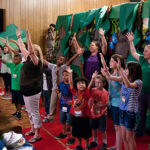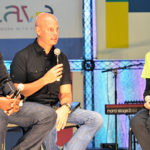DALLAS—Because Christians recognize the reality of sin, churches have the potential to lead honest interracial dialogue that could unite a polarized nation, a sociologist told a Texas Christian Community Development Network conference.
 George Yancey, professor of sociology at the University of North Texas in Denton, spoke to the No Needs Among You Conference. (Photo/Ken Camp)“New models of interracial communication coming from the church will strengthen Christians’ witness in an post-Christian society,” George Yancey, professor of sociology at the University of North Texas in Denton, told the No Need Among You Conference at Cliff Temple Baptist Church in Dallas.
George Yancey, professor of sociology at the University of North Texas in Denton, spoke to the No Needs Among You Conference. (Photo/Ken Camp)“New models of interracial communication coming from the church will strengthen Christians’ witness in an post-Christian society,” George Yancey, professor of sociology at the University of North Texas in Denton, told the No Need Among You Conference at Cliff Temple Baptist Church in Dallas.
Although Christians have been involved to some degree in the political movements that grew around the #blacklivesmatter and #alllivesmatter hashtags on social media, each originated out of a secular mindset that fails to consider the reality of sin and human depravity, Yancey asserted in a keynote address.
In contrast, churches hold a realistic view of human nature that acknowledges sinful motives, attitudes and actions—not only in the other person who is “different,” but also in themselves, he noted.
Reality of a racialized society
“Whatever we have today, it’s not true communication,” said Yancey, an African-American. “We live in racialized society—a society where race matters profoundly for differences in life experiences, life opportunities and social relationships.”
In a racialized society, people hold drastically different views about how to define racism, he insisted. White Americans tend to define racism in terms of overt actions from one individual to another, while people of color generally believe structural and social institutions can perpetuate racism, even when individuals do not intend to be racist, he explained.
Unfortunately, sociological studies indicate deeply entrenched views of racism as exclusively individual or as societal often are even more pronounced in churches than in society at large, he noted.
Polarizing power of social media
Sign up for our weekly edition and get all our headlines in your inbox on Thursdays
For all their differences, the Black Lives Matter and All Lives Matter movements hold some things in common.
“Both groups expect compliance to their ideology,” he said. “Both groups demonize those they disagree with. In both groups, most of the energy in the movement is toward boundary maintenance … (defining) who is with us and who is not with us.”
Rather than facilitating honest communication and meaningful dialogue, social media tends to deepen division, Yancey observed.
“Social media reinforces the view that we are right,” he said. “Boundaries between different groups harden. Each racialized event becomes an opportunity to demonize and fight the out-group.”
Secular sociologists call it “confirmation bias,” but Christians recognize it as humanity’s sinful nature, Yancey said.
“None of us is pure of heart when we talk about race relations,” he said.
Mutual-obligation approach
Yancey proposed what he calls a mutual-obligation approach to improve communication based on two underlying assumptions: “We all have a sin nature, and everyone has an obligation to work toward healthy interracial communication to solve our racial problems.”
If participants in dialogue take those principles seriously, nobody will dictate answers to others, everyone will have opportunities to be heard, and people on both sides can work toward mutually acceptable solutions, he said.
Honest dialogue demands active listening that assumes the best intentions of the other party and requires patience and persistence, he said.
Steps toward solutions
In a conference workshop, Yancey outlined five steps to move toward solutions, using the mutual-obligation model:
- Define the racial problem. Keep in mind a mutually defined specific problem rather than broad platitudes and lofty goals.
- Identify the critical core. Find points of potential agreement that could serve as agreed-upon goals.
- Recognize the cultural or racial differences at work. Keep in mind each participant in dialogue will approach the conversation from a distinct starting point.
- Develop ideas that address the concerns of racial out-groups. Neither party should presume to know how the other feels, but both should listen actively and attentively.
- Work toward a solution that can be accepted by all. “If the body of Christ illustrates solutions, the world will notice,” Yancey said.














We seek to connect God’s story and God’s people around the world. To learn more about God’s story, click here.
Send comments and feedback to Eric Black, our editor. For comments to be published, please specify “letter to the editor.” Maximum length for publication is 300 words.